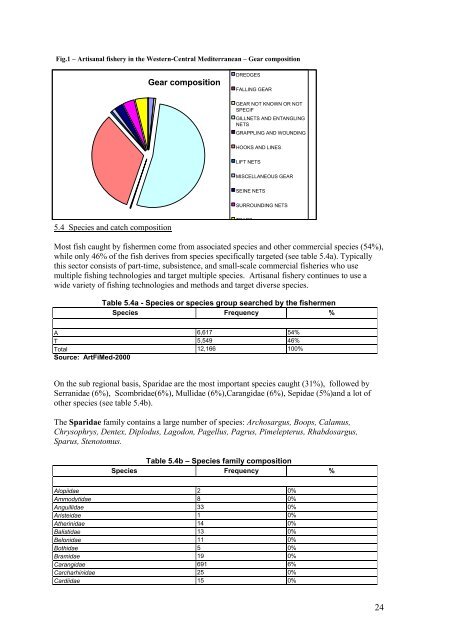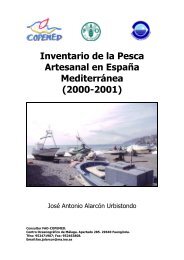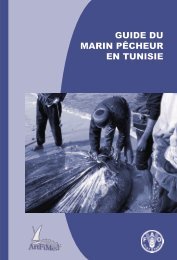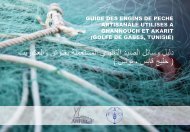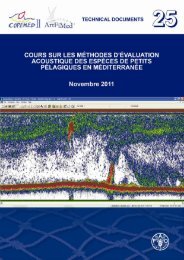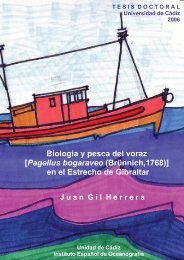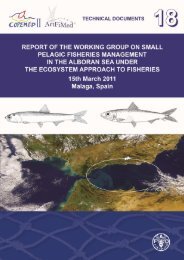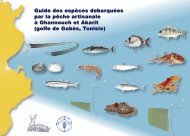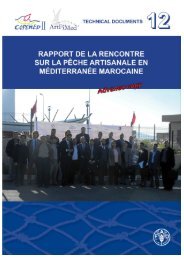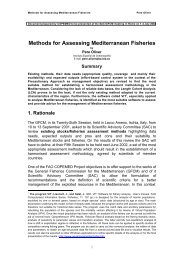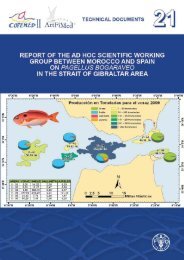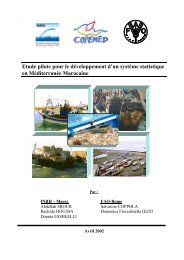Inventory of Artisanal Fishery Communities in the ... - Fao - Copemed
Inventory of Artisanal Fishery Communities in the ... - Fao - Copemed
Inventory of Artisanal Fishery Communities in the ... - Fao - Copemed
Create successful ePaper yourself
Turn your PDF publications into a flip-book with our unique Google optimized e-Paper software.
Fig.1 – <strong>Artisanal</strong> fishery <strong>in</strong> <strong>the</strong> Western-Central Mediterranean – Gear composition<br />
Gear composition<br />
DREDGES<br />
FALLING GEAR<br />
GEAR NOT KNOWN OR NOT<br />
SPECIF<br />
GILLNETS AND ENTANGLING<br />
NETS<br />
GRAPPLING AND WOUNDING<br />
HOOKS AND LINES<br />
LIFT NETS<br />
MISCELLANEOUS GEAR<br />
SEINE NETS<br />
SURROUNDING NETS<br />
5.4 Species and catch composition<br />
TRAPS<br />
Most fish caught by fishermen come from associated species and o<strong>the</strong>r commercial species (54%),<br />
while only 46% <strong>of</strong> <strong>the</strong> fish derives from species specifically targeted (see table 5.4a). Typically<br />
this sector consists <strong>of</strong> part-time, subsistence, and small-scale commercial fisheries who use<br />
multiple fish<strong>in</strong>g technologies and target multiple species. <strong>Artisanal</strong> fishery cont<strong>in</strong>ues to use a<br />
wide variety <strong>of</strong> fish<strong>in</strong>g technologies and methods and target diverse species.<br />
Table 5.4a - Species or species group searched by <strong>the</strong> fishermen<br />
Species Frequency %<br />
A 6,617 54%<br />
T 5,549 46%<br />
Total 12,166 100%<br />
Source: ArtFiMed-2000<br />
On <strong>the</strong> sub regional basis, Sparidae are <strong>the</strong> most important species caught (31%), followed by<br />
Serranidae (6%), Scombridae(6%), Mullidae (6%),Carangidae (6%), Sepidae (5%)and a lot <strong>of</strong><br />
o<strong>the</strong>r species (see table 5.4b).<br />
The Sparidae family conta<strong>in</strong>s a large number <strong>of</strong> species: Archosargus, Boops, Calamus,<br />
Chrysophrys, Dentex, Diplodus, Lagodon, Pagellus, Pagrus, Pimelepterus, Rhabdosargus,<br />
Sparus, Stenotomus.<br />
Table 5.4b – Species family composition<br />
Species Frequency %<br />
Alopiidae 2 0%<br />
Ammodytidae 8 0%<br />
Anguillidae 33 0%<br />
Aristeidae 1 0%<br />
A<strong>the</strong>r<strong>in</strong>idae 14 0%<br />
Balistidae 13 0%<br />
Belonidae 11 0%<br />
Bothidae 5 0%<br />
Bramidae 19 0%<br />
Carangidae 691 6%<br />
Carcharh<strong>in</strong>idae 25 0%<br />
Cardiidae 15 0%<br />
24


